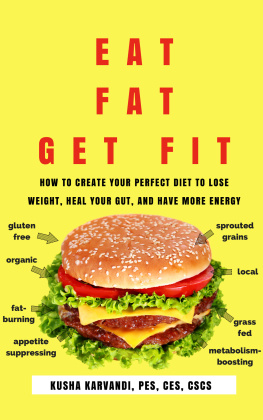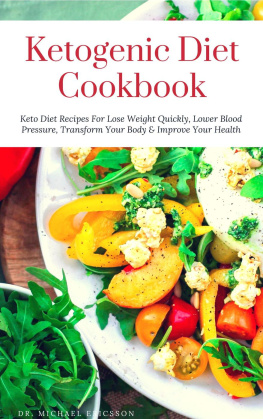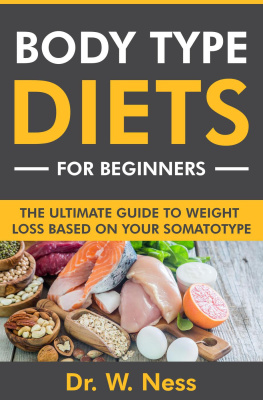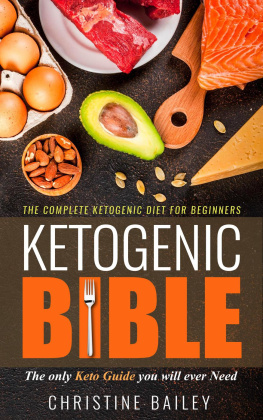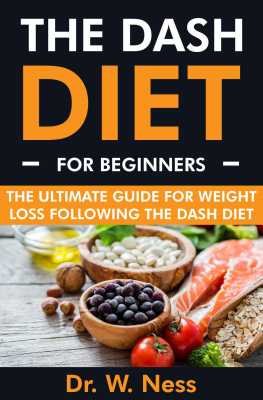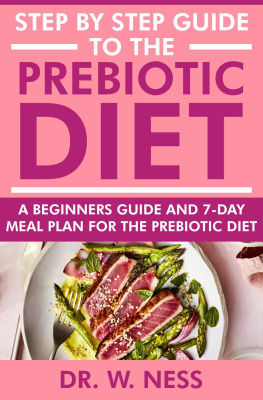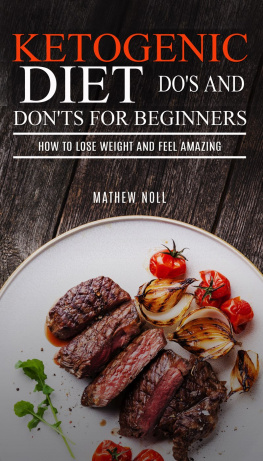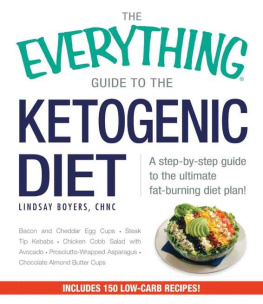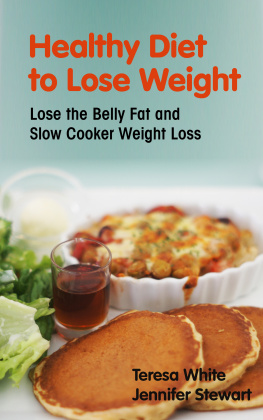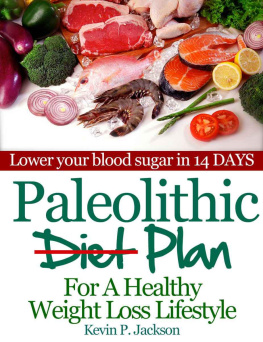Eat Fat, Get Fit
How to Create YOUR Perfect Die t to Lose Weight, Heal Your Gut, and Have More Energy
Kusha Karvandi, PES, CES, CSCS
Copyright 2017 by Kusha Karvandi, PES, CES, CSCS. All Rights Reserved.
No part of this book may be reproduced, stored in retrieval systems, or transmitted by any means, electronic, mechanical, photocopying, recorded or otherwise without written permission from the author.
Published by TCK Publishing
www.TCKPublishing.com
Get discounts and special deals on our best selling books at
www.tckpublishing.com/bookdeals
CONTENTS
About This Book
He who has health has hope. He who has hope has everything.
- Arabic proverb
Most of my clients come to me with a goal to lose weight in specific areas. They want flat abs, tighter tummies, leaner legs, or less flabby arms. But they often don't think it's possible to quickly eliminate body fat in one particular area because thats what theyve been told by previous coaches or what theyve read in diet and exercise books. But I have seen my clients get the results they want faster than ever by using my individualized approach to help them become their own diet detectives and find which foods work best for their body. Now I want to share my individualized approach with you so you can have the body and confidence you desire.
What drives me crazy about the health and fitness industry is that it makes people think they are weak and that the best way to achieve the body they want is to suck it up and push harder. Just look at popular tv shows like the biggest loser where trainers exhaust the participants with 8 hours of exercise per day and put them on extremely low calorie diets. But if more were better, why is it that the majority of these participants rebound and gain all their weight back and then some?
The truth is, youre stronger than you think. It isnt that you somehow lack willpower or discipline, its that you just dont yet have the right heuristic, which a mentor of mine once defined as the ability to make a decision based on limited information. The beauty of a heuristic is that it doesnt drain your willpower the way calorie-counting or other fad diets can. In this book, Ill share with you how to craft your own diet heuristic so you can make good eating decisions no matter where you are or how much willpower you have.
The hardest part about getting in shape and losing weight is taking the first step. So dont worry if youve never been able to achieve your goal before. We tend to believe failure begets failure, but nearly all success stories begin with generous amounts of failure. If youve tried diets before that didnt work, dont worry because what Im going to teach you isnt a diet its a way of thinking. With the right lens youll be able to look at nutrition and fat loss differently, and make decisions that will get you results you can keep.
I know what youre thinking. This is just another quick fix gimmick. How could it be that one can eat flavorful, satiating foods and actually lose weight? Believe me, I thought the same thing when I began to study this concept. But what I found is that our bodies arent programmed for obesity. Of course everyone has their own individual, natural set-point when it comes to weight. But when we began eating unnatural, processed foods, vegetables oils, and refined carbohydrates we shifted the nature of our body toward fat storage instead of fat burn.
In this book, Im going to provide you with the tools to eat well while reaching your goals quickly. While your naysayers are counting calories, feeling deprived, and still struggling to lose weight, youll be vibrant, full of energy, and supercharging your metabolism for sustained fat loss.
*Eat Fat, Get Fit is for educational purposes only and is not intended to diagnose, treat, cure, or prevent any disease. Always consult with your healthcare professional before beginning a new diet or supplement regimen.
How the Body Works
Energy Systems
ATP PC Energy Pathway
The ATP PC energy pathway works to provide about ten seconds worth of energy for activities such as sprints or heavy weight lifting. The benefit of this particular energy pathway or source is that it requires no oxygen and produces energy quickly.
How exactly does the pathway work?
As the name suggests, there are two components that play a role: ATP, known as Adenosine Triphosphate, and PC, known as Phosphocreatine.
ATP is the usable form of energy most commonly stored in muscle cells for muscular activities. Other forms of chemical energy those absorbed from food must be converted into ATP before the muscle cells can actually use them.
PC, at the same time, is stored in the muscle cells. When broken down, PC releases a significant amount of energy and part of that energy is used to resynthesize the ATP.
The storage of both ATP and PC is significantly small, however, which is why the ATP PC energy pathway supplies only about ten seconds worth of energy.
As the body engages in physical activity and the energy capacity of the ATP and PC energy system is used up, the body will move on to either aerobic or anaerobic metabolism to continue with the creation of ATP (fuel).
Being aware of how your body uses the different types of energy found in a variety of foods will help you begin to make conscious decisions about the type of energy you consume at a given time of day. In this case, simple carbohydrates such as fruit would be ideal to consume 30 minutes before physical activity because of the bodys ability to convert the fruit into usable energy quickly. Coconut water is another excellent choice because it not only provides natural sugars but also blends the perfect balance of electrolytes.
The Anaerobic Metabolic Pathway
Better known as glycolysis (because it involves the breakdown of sugar), the anaerobic metabolic pathway leads to the breakdown of sugar to produce energy the manufacturer of ATP from carbohydrates.
Glycolysis gives off energy through the partial breakdown of sugar without the need for oxygen. Similar to the ATP PC energy pathway, it provides a quick supply of energy used in short and high-intensity bursts of activity. Each burst of energy lasts for only one to three minutes before the lactic acid accumulation reaches the lactate threshold.
When this threshold is reached, there is intense muscle pain, a burning sensation, and fatigue without the availability of another, alternate energy source.
Knowing that you are going to engage in short bursts of intense activity, such as weight training, you can plan ahead and select a snack or meal that will provide a good source of energy to support the anaerobic metabolic pathway one that is relatively high in carbohydrates, such as brown rice or yams. Making a selection like this in anticipation of a certain type of activity will help your body be efficient about its energy usage.
Aerobic Metabolism
Aerobic metabolism provides most of the energy necessary for our daily activities, including physical activity that lasts more than one to three minutes. It is used primarily during less intense activities. It is also the fallback energy pathway for most endurance exercises.
A more complex system than the other two energy pathways, aerobic metabolism uses oxygen to convert protein, fats, and carbohydrates to ATP. The process for creating ATP via this method takes more time and relies on the bodys circulatory system to transport oxygen to the working muscles.
A physically active person will generally move through these metabolic pathways as they exercise. When they begin their workout, anaerobic metabolism kicks in and produces ATP. As breathing becomes more rapid and the heart rate increases, more oxygen is available for aerobic metabolism.
Next page
